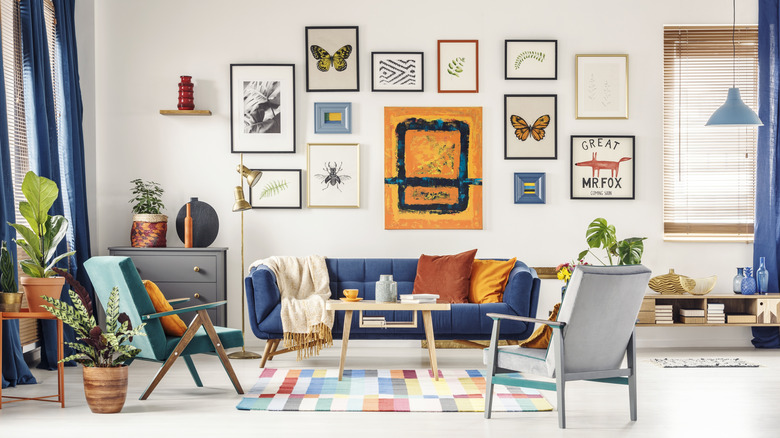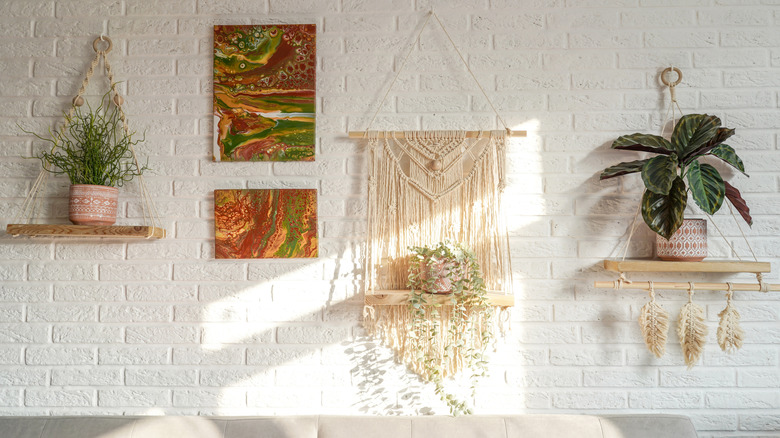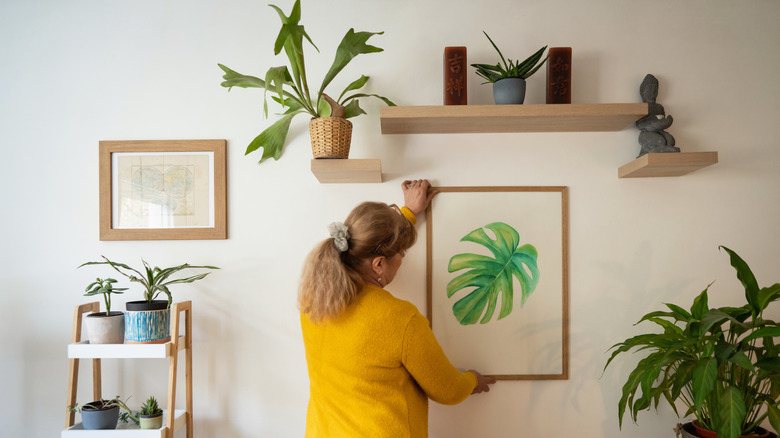Why You Should Add A Shelf To Your Gallery Wall
We may receive a commission on purchases made from links.
When you say the word "gallery," it's likely that certain images pop into your head right away. Usually, those mental images consist of a wall of pictures and little else. While there's something to be said for hanging up pictures only, in the end, such an arrangement looks visually flat. What the space could really use is some depth, a little flexibility, and even some quirkiness that two-dimensional art alone can't deliver. This is where adding a floating shelf can really help to create the perfect gallery wall.
This has to do with the versatility that comes with floating shelves. Take a kitchen gallery, for example. It may consist of illustrations of seasonal vegetables and photos at a pumpkin patch. It looks pretty, but might lack visual depth. However, add a rustic-looking shelf, like the Fun Memories Floating Shelf, and suddenly you've got a perch on which to display your antique cookbook or a small spice jar collection. Your kitchen gallery is no longer just mass-produced fruit prints.
However, gallery shelves don't just give you a place for cookbooks. They're a decorative element that works in any gallery in your home. In the kids' rooms, wooden blocks that spell out the child's name find the perfect home within the artwork. In the living room, the shelf offers a perch for a vintage clock, decorative candles, or an aloe vera plant. In short, the galleries' dull flatness is replaced by areas of visual depth and texture thanks to the flexibility some deftly placed floating shelves have given you.
Mixing and matching decorative and seasonal elements
Further, if you're the sort whose restless decorative spirit prompts a complete rearrange of the living room furniture every 90 days or so, then this interior decorating hack can revamp your space completely. To hang a gallery that looks balanced takes planning. Sometimes, moving your gallery around is more difficult than pushing around your furniture. A few floating shelves added to your gallery space changes this decorative dynamic. In this scenario, you don't need to rehang the whole gallery. Instead, you can strategically change out the decorative elements you put on the shelves without disturbing the rest of the core pieces. Consider how this would play out as the holidays change throughout the year. October's mini pumpkins and Halloween artwork get replaced by a Christmas portrait and a wooden nutcracker in late November or early December.
However, you're not limited to placing seasonal items on your shelves. You can use them to add new pieces of artwork to your gallery's visual mix. Certain elements, like common color schemes and similar frame styles, allow you to work the new in with the old because they provide visual continuity. Once you have that visual thread in place, you're free to place new pieces like framed postcards from your vacations or a small 8-by-10 inch painting on the shelves in between photos and artwork. It looks like a whole new gallery even though it really isn't, thanks to those floating shelves and the new items you placed on them.
You can fill in big or small gaps in the gallery
Even with the best-laid plans, your wall gallery might end up with some weird gaps or space constraint requirements that you just can't fix with pictures alone. In many cases, the normal go-to solution for such an issue would be to start over completely and rehang the gallery. However, you may be able to sneak in a shelf that solves the design problem at hand. For example, say there's a 7-inch gap between pictures that, in context, looks a little too wide. Rather than rehanging the artwork on one or both sides of the gap, consider hanging a small 5-inch-wide shelf in the gap instead. Then add something like a bottle of vintage wine or decorative vase. It introduces visual interest to the area while closing the oddly-spaced gap. No rehanging is required, and it's a luxe home design alternative to basic gallery walls.
This concept works in reverse, too. If you have a big gap on the wall that was left once you move an armchair away, for example, a long shelf and a large 18-by-24 inch painting could be slipped into the spot to cover the gap. This can be replaced by two small paintings down the road. The shelf stays as a placeholder, regardless of how big the artwork is. In both of these cases, the shelves give you the option of placing items to fit the constraints of the space, without requiring you to move everything around.


